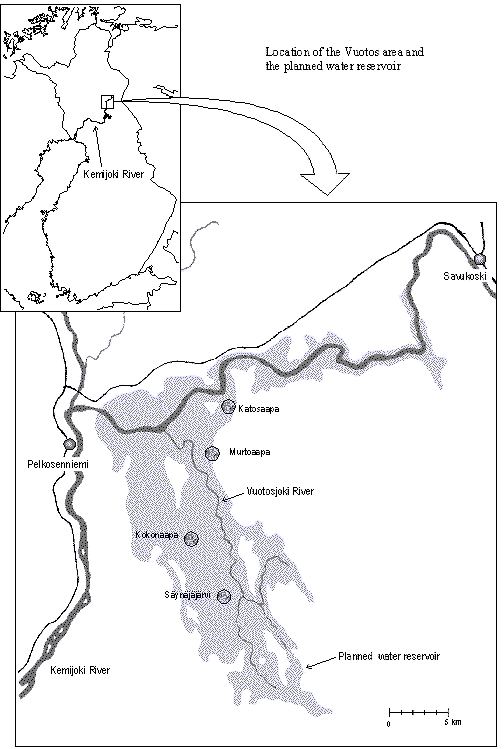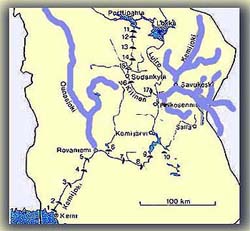|

SUMMARY OF THE VUOTOS-PROJECT

A photo from the web side: http://koivu.oulu.fi/tati/JR/Kaukok/Vuotos/Vuotos.html
 The
next map The
next map
|
The decision in 1982 by the Finnish government
not to construct the Vuotos-reservoir was well founded (see the enclosed
statement of the ministry of interior). The
"YES"decision of 1992 was, however, without any
justification, immoral, a political decision. Consider the negative
impact of the project on the national economy and the environment,
shown by various studies. |
|
In Pelkosenniemi the people who have opposed the
reservoir for thirty years have got along and made a living in the
region although burdened by the threat of the reservoir. A merciless
machinery weighs down on them. These people became the victims when
the decision of 1982 was not made into a law. |
|
See map showing the unharnessed and valuable
rivers: the Ounasjoki and the upper parts of the Kemijoki, the only
free rivers in the large rainfall area of the Kemijoki covering 75
per cent of the area of Lapland. A limit for harnessing has been
reached, enough sacrifices have been made for energy production.
There are plans to build
the both unharnessed rivers right to the end. |

Only two rivers of the River Kemijoki, the
Ounasjoki and the upper parts of Kemijoki, remains unharnessed.  The
next map The
next map
|
The population of Pelkosenniemi: 2751 in 1962,
1569 in 1982 after which a slight growth for two or three years. The
"NO"-decision of 1982 returned people's belief in life
again. After a steady decrease the population reached under 1400 this
year. The trend has been considerably worse compared to other
communes with the same social and economic structure. |
|
The high officials of Pelkosenniemi have always
been in the "PRO"-party exerting a lot of power at the
local level. All small scale projects have been effectively frozen,
the Vuotos-project being the only goal. For instance the funds for
forest regeneration were refused, modernizing cowsheds, building new
buildings starting as early as the 1960's -the result being the
gradual loss of population in the region. |
|
The 1982 "NO"-decision started an
economic revival project which was, however, carried out hastily and
giving emphasis to intense forest management. According to official
reports the project reached its goals. |
|
Immediately the "PRO"-party started
working against the decision, which resulted in arguments and
controversy and affected social relations (even between family
members) very negatively mostly in Pelkosenniemi but also in the
neighbouring communities. Dividae et impera, the only jobs worth
keeping alive are the jobs of the Kemijoki company (at the moment
this seems to be the main argument of the "PRO-party). |
|
The project is a senseless one offered with
misleading information: there is talk of thousands of jobs, an
Eldorado. The greater the lie, the greater the truth - the reservoir
is described as "a historical necessity". The whole of the
Kemijoki is at stake, it is being broken down little by little. In
the name of the interests of Lapland also Finland's greatest natural
assests are being destroyed: unpolluted nature, the unharnessed
rivers, the wilderness etc. |
|
Paradoxically the Vuotos-area is the best area
in Pelkosenniemi where almost all the land of c. 500 farms used to
lie. Almost 40 per cent of wood production (14000 k-m3/a year),
suitable terrain for reindeer herding, the unique Kemi Islands used
as pasture, berry picking (especially cloudberries). The area is
popular among nature lovers: boating on the river, fishing, hunting,
bird watching etc. A paradox: the Kemijoki company takes credit for
buying out the farmers in the area - 80-90 per cent of land is owned
by the company even before the project has been dealt with by the
water court. The result: migration away from the area. |
|
It is shocking to have to prove the value of a
great, unharnessed river. The Vuotos area would be drowned just to
keep the engineers of the power company employed in planning and
constructing a project whose emissions into the air, soil and water
would surpass those allowed for any factory or power plant. The
fresh, unpolluted water of the upper Kemijoki would be mixed in the
reservoir with marsh turf or sod etc. This would spoil the water
downstream as far as the northern part of the Gulf of Bothnia and the
territorial waters of Sweden. The present purifying effect would
disappear and a huge flow of nutrients would enter the river ( e.g.
phosphorus 170 kg/24 hours). The figures offered by the power company
about electricity production, emissions, environmental impact,
employment etc. have been questioned with good reason. |
|
The area drowned by the reservoir would be 23800
hectares compared to a power plant, for instance, 2 hectares, ratio 10000/1. |
|
The Kemijoki company would have plenty to do in
improving the condition of the river, in raising the regulating
capacity of the existing reservoirs by dredging, in replacing wornout
machinery and getting new machinery in the existing power stations,
in developing wind power, in the utilization of the geothermal energy
of the basins etc. |
|
When studying the studies made about the
reservoir I have come across a strange thing: the figures given by
the official organizations such as the organization of the communes
of Lapland, the town of Kemijärvi or the Kemijoki company are
all correct however much they differ from each other. The purpose for
which the figures are used determines which figures are chosen.
Consider the figures about the potential jobs created which range
from 100 to 1000 jobs for ten years - these figures have been given
by the "PRO"-party... Also these figures are dependent on
the permission of the water court to go ahead with the preliminary
work - a permission which may never be given - I don't believe the
water court could be so terrible ! |
|
There is an attempt to undermine all critical
scientific research done so far, not to say anything about common
sense and the local people's everyday experience. The Kemijoki
company even tries to negate the conclusions made by top researchers
from Oulu University about the unique environmental value of the Vuotos-area. |
|
A beautiful vision, an illusion, has been
created about the future multipurpose use and recreational facilities
offered by the reservoir. At the same time the project is described
as one which requires the commitment of individuals, communities and
the Finnish state. By a conservative estimate the investments would
sop up an extra billon marks of tax-payers' money and there would be
no guarantee of the results. |
|
If a fraction of the sum mentioned above were
invested in the area now there would be no doubt about the
opportunies created for forestry, fishing and recreational use. |
|
The Vuotos project is without any judicial,
economic or ecological basis. The process which is going on in the
water court just contributes to the slow death of the area. A
"NO"-decision has to be made as soon as possible and made
into a law. Also all the land owned by the Kemijoki company must be
taken over by the Finnish state. After that nature reserves will be
established, land for economic activity will be obtained by right of
redemption and efforts will be made to develop the economy of the area. |
THE STATEMENT BY THE MINISTRY
OF INTERIOR TO JUSTIFY THE DECISION NOT TO GIVE PERMISSION FOR THE
CONSTRUCTION OF THE VUOTOSRESERVOIR
|
The Vuotos-project can be considered
unprofitable from the point of view of the national economy,
disadvantageous for the demographic structure of the local
communities, competing for financing with other projects which could
bring more permanent relief for unemployment, destroying natural and
environmental values, causing difficulties for fishing and reindeer
herding and primary production. Therefore it is a project which
should not be carried out. |
|
N.B. The decision was made in 1982 when
environmental values were not given the emphasis they get now. Start |
More information:
MEP: Heidi Hautala |
|